► Interview with Mate Rimac
► 1-2-1 with EV disruptor
► Inside line with Croatian pioneer
‘You can’t go for coffee with him,’ Mate Rimac’s PR director Marta tells me when I explain the more relaxed, conversational concept for our Coffee With CAR series of interviews. ‘He’s really happy to meet you. He’ll tell you anything you want to know. It’s just that he doesn’t drink coffee. He doesn’t need it. He’s 32 now, and I think he’s been awake since he was 17.’
So here it is: the rather less appealing-sounding CAR Gets Water With Mate Rimac. The beverage may be boring but the subject is anything but. Let’s start at the end, because if you only associate Rimac Automobili with its two all-electric hypercars you might be surprised at the scale and significance of what else its young founder is doing on the outskirts of Zagreb.
As I visit, the last two of just eight Concept Ones are being assembled, and the production version of its successor, the C_Two is being signed off before its planned launch in March at the cancelled 2020 Geneva motor show.
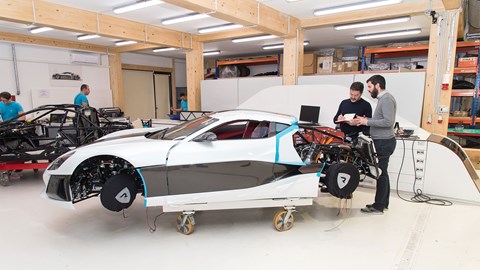
But although he’s only delivered £7.4m of cars thus far, Mate has built a business worth over half a billion pounds at its most recent funding round last summer – and probably a lot more by now – by supplying his very high-performance electric-drive technology to other car makers. When I ask him how many, he lists those we already know about, like Aston Martin, Koenigsegg and Pininfarina, then carries on counting the still-secret ones silently on his fingers to get to 15.
Porsche and Hyundai are investors, and the business employs 600 people. Croatia is three years younger than even the precociously young Mate, and spent its first four years fighting for independence. Along with its giant-killing national football team, Croatia’s first and only car maker is a source of intense national pride for its four million citizens: its founder is a rock star here. When the taxi driver who collected CAR’s photographer from Zagreb airport learned that he was heading to Rimac, a collection of low, grey industrial buildings set amid car dealerships and furniture stores on the outskirts of the city, he recounted Mate’s career enthusiastically and accurately and it was a struggle to get him to accept the fare.
Meeting these seemingly omniscient, omnipotent tech titans can be a dispiriting experience for one-trick hacks like me. Mate is 32 and has a team of 19 geniuses working on his own, in-house autonomous driving code. I’m 45 and struggled to park my rental car in a well-marked bay outside his headquarters, even with a reversing camera. But Mate defies the trope of the hyper-caffeinated, messianic asshole tech entrepreneur in more ways than just his rejection of coffee. He is pleasingly unassuming, asking questions as well as answering them directly, but his energy and intelligence are apparent in the way he sits bolt-upright in an easy chair as we talk, and in the constant, rapid movement of his sharp dark eyes.
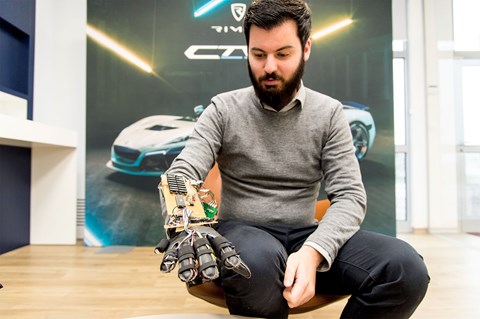
So now that you get why we’re interviewing a guy who has only built eight cars, let’s go back to the beginning. His name is pronounced ‘mah-tay rimats’: like Porsche it has a troublesome final syllable but he really doesn’t mind how you deal with it. It’s a Bosnian name, and he was born there before moving to Germany as a child, and then to Croatia aged 14, where he was teased for his Bosnian hick accent. It wasn’t a good time, he says, and he soon assimilated. His ability with electronics was apparent from an early age. He won an international prize for a sensor glove which he designed and made and which functioned as both keyboard and mouse, anticipating the trend for wearable tech.
‘I love tech, and my interest in electronics came naturally out of that,’ he says as he treats himself to a water. ‘But I was always a car guy first. Electronics came second. I’ve been obsessed with cars all my life. But I’m not a carburettor fan. When Porsche made the first water-cooled engine and people said this isn’t a real Porsche… I’m not like that. I like progress.’
More electric car reading
The best electric cars and EVs: our guide
How much does it cost to charge an electric car?
The fastest EVs
How electric car batteries work
Aged 18 he bought a knackered E30 3-series one year older than him to go racing in. When the engine blew he replaced it with an electric motor and painted the car green.
‘That car went through seven iterations. Each time it got better and faster. Sometimes I rebuilt just the battery, or sometimes everything from scratch. Of course the BMW is ancient for us now, like the Stone Age. But that spirit of pushing things and raising the bar is the same. Actually that’s a problem we have. We never stop. We always have a new idea, and sometimes pursue this one rather than finishing the previous one. From the Concept One to the C_Two absolutely nothing is carried over. And even with the C_Two, between the prototypes we have now and the car you will see in Geneva, almost nothing is carried over.’
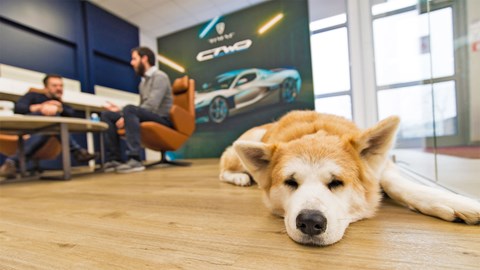
The BMW – or what remained of it – set five FIA performance records for electric cars. It’s being restored now, but there’s a photograph of it in reception at Rimac headquarters, with an even younger Mate standing slightly dorkily in front of it in a race suit and sneakers. It looks a bit Max Power, and it’s hard to believe that it has spawned a business with a valuation heading for 10 figures.
What Mate really wanted to do was build an electric supercar. The BMW provided the test bed and the credibility. With funding from backers in Abu Dhabi, the Concept One was designed in a summer and shown at Frankfurt in September 2011. Mate knew that he’d never make any money building such cars in tiny volumes, but the Concept One’s 1224bhp and 2.5sec 0-60mph time got the attention of the big suppliers and car makers who wanted a head start on their own high-performance EV projects. They started to fly into Zagreb: not somewhere they’d done business before.
‘Of course we didn’t get all the projects we were bidding for,’ Mate says. ‘Sometimes the fact that we are in Croatia and I was a 20-something year-old guy was too high a risk for them. And I understand that, because companies in this industry can be huge, and they’re not used to dealing with companies on the tiny scale we had back then. Hyundai has four times more revenue than Croatia has GDP. Crazy. Even Bosch as a supplier is a bigger than Croatia as a nation. So working with a little company from Croatia is already a stretch, and then you have all of these other factors, a 20-year-old guy, a start-up company, blah blah…’

‘So one of the things I did was to grow a beard to look more serious. I have a baby face. When I was in my twenties I still looked like I was 17. And it’s not just customers you have to convince. There’s also investors, and potential employees who have to give up well-paid jobs elsewhere. Maybe the beard helped. I still have it, anyway.’
I want to understand why companies like Porsche and Hyundai, who didn’t just buy Mate’s tech but bought into the business, couldn’t just use their crushing budgets to develop their own tech and erase his advantage.
‘It’s a focus on performance. We are focused on a niche. Our powertrain systems are the highest power density, and the highest energy density. That’s what we’re best at. If you need to have as much power in as little space as possible, you come to us. You don’t come for the cheapest components.
‘That’s a Koenigsegg Regera battery over there. It has seven kilowatts per kilogramme. A Tesla battery is less than one kilowatt per kilogramme. Sure it’s for a different purpose, but even a LaFerrari or Porsche 918 battery is only maybe two or three kilowatts per kilogramme. We have the proprietary technology like battery cooling, battery management and high-performance inverters. Everybody’s now starting to talk about 800 volts, but we’ve been on 800 volts since 2011.’
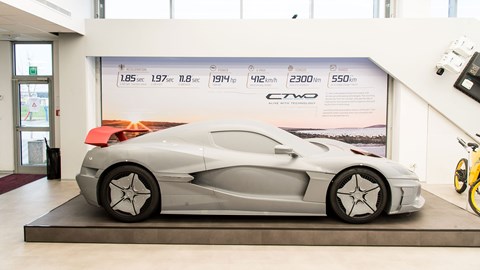
The other main reason for Rimac’s success becomes obvious as we walk to the workshops. A prototype C_Two (above: 1914bhp and 0-60mph in 1.85sec) is on a four-post lift being pulled apart, and with its panels off and its guts partially eviscerated Mate and I can peer into its innards, a glorious tangle of cables and hoses running around a handmade carbonfibre chassis, and aluminium machined into elegant, organic-looking, mass-reduced components. All of it has been made here, and if a big name needs a quick EV in hurry, Rimac can handle the project from sketch to production.
‘Not one part in there is shared with another car,’ Mate says. ‘It’s pretty rare to start entirely from scratch for a new car. But you can’t create something different if you cook with the same water. And anyway, in the beginning we didn’t have the money to pay the big guys to make stuff for us, and most of them didn’t even want to work at our tiny volumes. So I had no choice. The only way to do it was on our own.
‘Also, if you just buy parts in, what know-how or value do you create in your own company? My thinking was that if we had the guys who develop the chassis sitting next to the guys doing the inverters and the guys doing the battery, we could integrate everything better, and make better cars.’
He even makes the stuff that most high-end car makers quietly outsource, like the trim, the infotainment and even a simple autonomous driving system which will show you the quickest way around a circuit.
‘If you go to Lamborghini, the infotainment is pretty much the same like an Audi. That was no-go for me, to have buttons and infotainment and this kind of stuff from other cars. And the other reason for doing it here is to create the jobs and know-how in Croatia, instead of in Germany or Italy.’
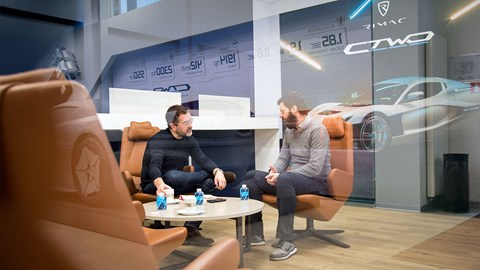
We do most of our talking in a glass-walled meeting room next to reception, where a constant stream of young, smartly-dressed and nervous looking visitors are reporting, presumably for job interviews. They stare at bit too obviously at Mate when they catch sight of him, with Nala, his ever-present Japanese Akita dog helping to distinguish him from the legions of other casually dressed, scruffily bearded and very young employees. Nobody looks older than 35, and I feel like William Rees-Mogg at a Stormzy gig. Like most start-ups, there are chill-out zones with beanbags and Xboxes, but everyone’s too busy to use them.
Perhaps predictably, Mate has been hailed as Europe’s answer to Elon Musk by the Financial Times and the Wall Street Journal, among others. He idolises Elon but is quick to demur, pointing out that Rimac’s only delivered eight cars so far. But in other respects the comparison is valid. Both founders are driven by a sense of mission rather than financial gain. Both are intimately involved in the tech. And both lead businesses which are highly reliant on their founder’s personal mojo.
‘My 43 per cent in the company is worth hundreds of millions at the moment and, if everything goes right, it will be in the billions,’ Mate says. ‘But I’m not in this for money. I have a very normal salary. In the US, the average CEO earns 287 times more than the average employee. I earn three times more than our average employee. And that’s all the income I have. I’ve had offers to buy the company, but if I walk away now with a hundred million euros in my pocket and the company doesn’t achieve the clear goals I have for it, I wouldn’t feel satisfied.’
Those goals seem remarkably modest. Mate says that in five years he’d like to be supplying components to, and building, low-volume high-performance EVs for the big names – which he’s effectively already doing – and building a small range of Rimac supercars, with annual numbers kept below 100. He gets started on that later this year with the C_Two.

One obvious difference between Mate and Musk is that one of them clearly prefers to under-promise and over-deliver, and you suspect that the Rimac of five years hence will look very different. For its shareholder Hyundai, Rimac is developing a halo EV like those it has made before, but also a plug-in EV/fuel-cell hybrid concept which, if it makes production, would be a far more mainstream car than any it has worked on (openly) before. You wonder how long Mate will be able to maintain his focus on high-end EVs, and how dramatically and profitably Rimac might help car companies with their mainstream EVs. Maybe one day Zagreb’s cabbies will be driving Rimacs, rather than dreaming about them.
I tell Mate that his hero Elon told me long ago that he’d considered renaming Tesla after himself, but quickly decided that Musk made a terrible name for a car company. He laughs. ‘Rimac was called something else first, but some friends were pushing me to rename it after myself, which I didn’t really like. But Bugatti, Ferrari and Porsche all have the names of their founders, so I guess it’s a tradition.
‘And there really is no division between Rimac and me. My whole life is the company. I work like crazy. I do this day and night, and there is no plan B for me if this goes wrong. You’re a bad manager if you build a company that’s reliant on you. But the customers and shareholders and employees expect to talk with me. And I feel that this is such a crazy thing to do, and so fragile, and requires such levels of commitment and perfectionism, that if I let go, it just falls apart. It’s borderline impossible, what we’re doing here. For now at least, Rimac just can’t work without me.’
With 33 years to retirement, it will be a while before it has to. Imagine what he might achieve in that time if he starts drinking coffee.
Mate Rimac biography: how he got here
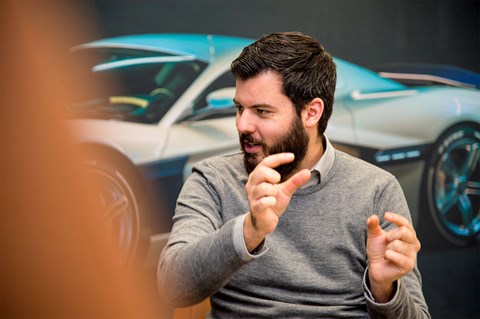
BMW beginnings
Aged 18, Mate buys an E30 3-series BMW to race. When the engine expires he replaces it with an electric powertrain. Making it fast and reliable gets Rimac noticed.
The first car
Rimac is founded in 2009. Two years later, at the 2011 Frankfurt show, the Concept One’s unveiled. The last of the eight customer cars are being completed now.
Powerful friends
2015: Koenigsegg unveils the awesome hybrid Regera, a gearbox-less hypercar with numbers to melt your mind. Key to its powertrain are Rimac components and expertise.
Porsche, Hyundai and Kia get involved
2018: Porsche buys a 10 per cent stake in Rimac. A year later the battery-electric Taycan is unveiled – Porsche also increases its stake to 15.5 per cent. Kia and Hyundai invest €80m as part of a strategic performance EV partnership.
More electric car news and advice